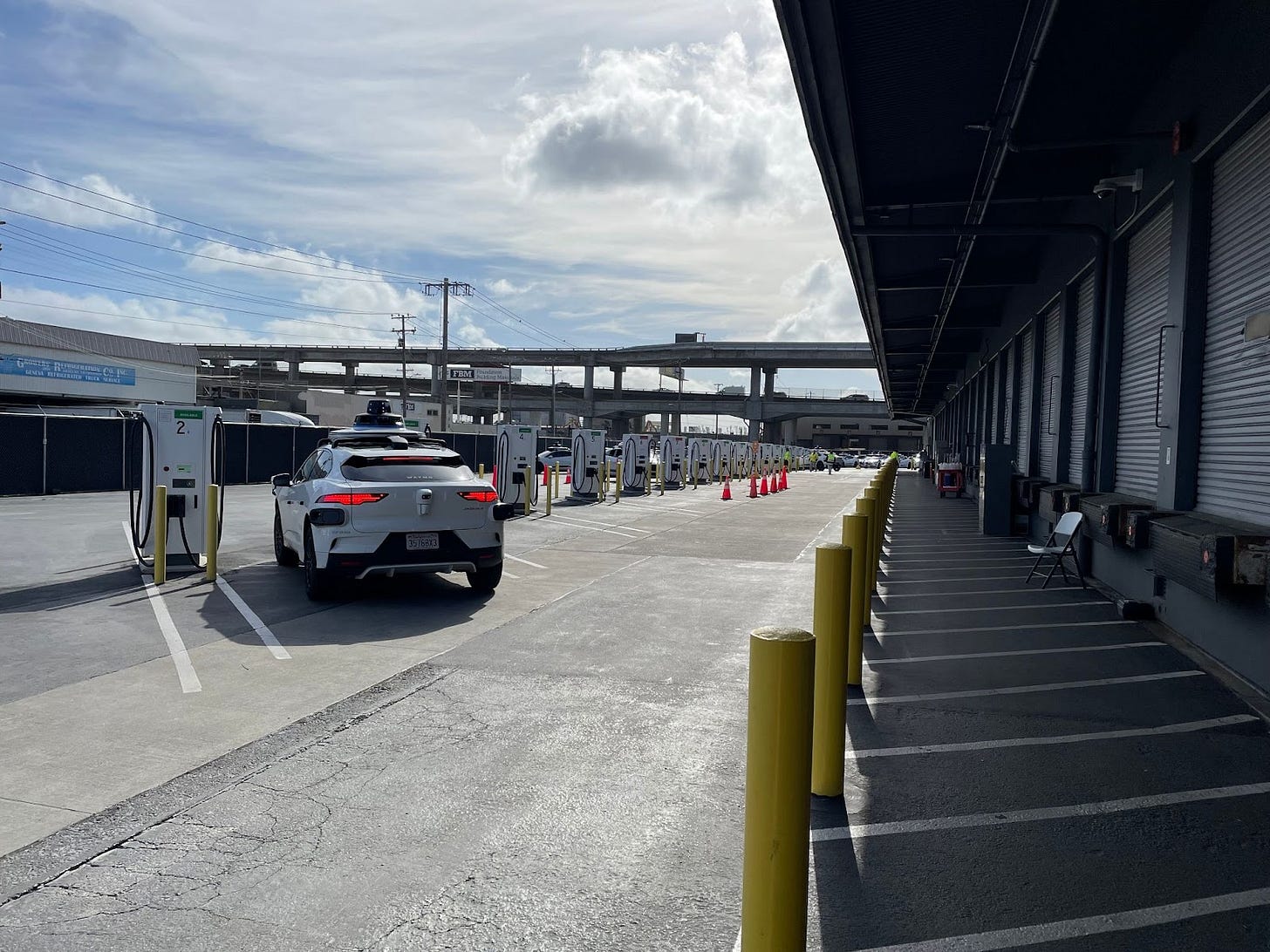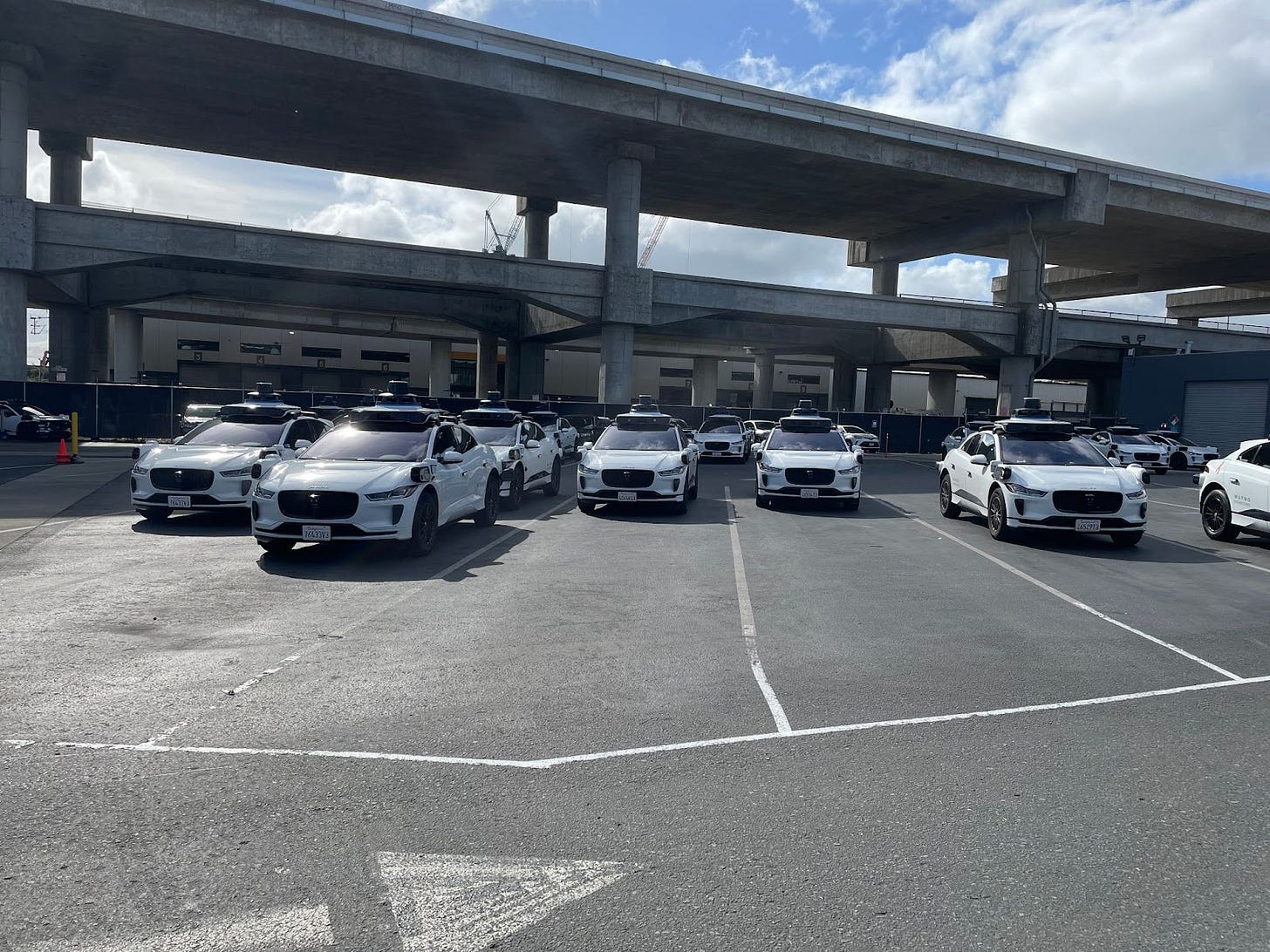Waymo’s investments in San Francisco may be paying off
Waymo cars blend into traffic so well San Franciscans barely notice them.
When I started working on Tuesday’s story back in March, I wasn’t expecting it to focus so much on Tesla. My plan was to take some Waymo rides, talk to some locals about their experiences with Waymo, and then write a Waymo-focused piece. But while I was there, I got an unexpected chance to test-drive Tesla’s FSD software. I decided that a Waymo vs. Tesla framing would make for a more interesting story.
But that meant leaving some of my Waymo-focused reporting on the cutting room floor. So today I want to share a few additional things I learned about Waymo in San Francisco.
I visited a Waymo depot

On a sunny morning in late March I traveled to Waymo’s depot at 201 Toland St. This is where Waymo’s vehicles get charged, cleaned, and repaired.
Located in a gritty part of southeastern San Francisco, the facility was sandwiched between a freeway overpass and some warehouses. It was surrounded by barbed wire.
Inside the fence were dozens of white Waymos with their distinctive black domes. A large warehouse stretched from the front to the back of the property. Running alongside it was a row of 19 charging stations, each capable of charging two vehicles.
A Waymo representative pointed out one recent innovation: when a vehicle needs to charge, it now drives itself to an open charger and shows a “low battery” icon on its dome so a Waymo technician can plug it in. Waymo doesn’t have to pay people to drive the vehicles around the lot.

The Waymo rep also pointed out there are two different types of vehicles in the lot. Most of the vehicles just said “Waymo” on the side—these are commercial vehicles that give rides to customers. But near the back of the lot there were a number of vehicles labeled “Waymo Engineering.” These vehicles were used—usually with safety drivers—to collect testing data and validate new versions of Waymo’s software.
Waymo is going to need to build a lot of facilities like this as it scales up across the San Francisco Bay Area and eventually across the US. And that won’t be easy—especially in a place like San Francisco.
Last year, Waymo sought a permit to convert the warehouse next door into some office space and a parking lot for Waymo employees. San Francisco’s Board of Supervisors unanimously rejected Waymo’s application.
The rejection was partly based on fears that Waymo would eventually use the space to launch a delivery service in the city (Waymo hasn’t announced any plans to do this so far). But it also reflected city leaders’ frustration with their general lack of power over Waymo. Because California regulates self-driving technology at the state level, San Francisco officials have little to no authority over Waymo’s operations in the city.
As Waymo scales up, it’s going to have to deal with frictions like this in metropolitan areas across the country.
You could argue that Waymo is making a mistake by doing all of this work itself. Perhaps it would make more sense for Waymo to license or sell its technology to third parties—car manufacturers, car rental companies, taxi companies, or someone else—and let them worry about the mundane details of charging, repairing, and cleaning vehicles.
But there’s a reason that innovative businesses are often vertically integrated. Having hardware, software, and support services all under one roof makes it easier for Waymo to experiment with different technologies and business models. I expect that once Waymo has figured out more of these details, it will look for ways to partner with other companies and offload the more routine aspects of running a taxi service.
San Franciscans are pretty chill about Waymo
The next day I visited San Francisco’s hilly Dolores Park to see how ordinary San Franciscans felt about the robots in their midst. I talked to about a dozen people—black and white, young and old.
Most of the people I talked to hadn’t ridden in a Waymo yet. Some were on the waiting list; others weren’t interested. One dad said he couldn’t remember if he’d ridden in a Waymo or not.
Another man said he wasn’t ready to get into a Waymo—but even he said he didn’t worry when he encountered the vehicles on the street.
A middle-aged woman with two kids told me she was sometimes annoyed at how slow they drove.
I had a long conversation with a guy walking his dog who worked in technology and seemed to closely follow the autonomous vehicle industry. He said the vehicles seemed safe based on his personal interaction with them.
Aside from that guy, people were mostly ambivalent about Waymo. They were neither excited about nor afraid of sharing the streets with two-ton robots. I got the impression that a lot of people weren’t thinking much about them at all.
And honestly this is an impressive achievement on Waymo’s part. The vehicles blend in with existing traffic so well that a lot of people have stopped even noticing them.
Waymo’s relationship with SFFD is improving
In early April, I had a chance to talk to Darius Luttropp, Deputy Chief of Operations for the San Francisco Fire Department, about how self-driving vehicles are impacting the work of firefighters in San Francisco. Historically, the SFFD has been a fairly harsh critic of Waymo and (while they were operating in SF) Cruise. When I last talked to Chief Luttropp in September, he told me that “we're not convinced that the technology is ready to be used in operations in the streets.”
The chief struck a more conciliatory tone in our April conversation.
Last year, firefighters filed dozens of reports of Waymo and Cruise vehicles interfering with their work. The number of reports is down significantly this year. I asked Chief Luttropp whether that’s because Waymo cars were doing a better job of staying out of the way of first responders.
Luttropp wasn’t sure. Firefighters aren’t required to file a report every time a Waymo car got in the way, so it’s possible that the reduced reporting reflects a “burnout on reporting.” “But I'm also pretty confident that the number of incidents has gone down,” he added.
Luttropp praised two specific steps Waymo has taken in recent months to reduce interference with firefighters:
Waymo has made it easier for firefighters to hop into the driver’s seat and take control of a Waymo vehicle. “The companies were very responsive with that,” he said.
Waymo built a system that lets the fire department geofence the area around a fire so Waymo vehicles automatically avoid it. Luttropp says this system works pretty well, but the “level of automation isn't quite where we'd like it to be. It still requires some work on both ends.”
At the same time, Luttropp complained that it wasn’t possible for a firefighter to talk to a Waymo representative using its external speakers and microphones. Instead, firefighters need to come to the driver’s side window and use the Waymo’s in-car audio system. Luttropp argued that is too burdensome for first responders who may be directing other vehicles at the same time.
Waymo says firefighters can also contact Waymo by cell phone using a QR code on the driver’s side window. However, Chief Luttropp told me in September that “the requirement to use a cell phone is kind of a line for us” because cell phones “aren't really technologies that lend themselves to an emergency situation.”
In February, SFFD tweeted out a video of a Waymo vehicle pulling over for a firetruck with its sirens on. The video had the caption “be this car.” I asked Chief Luttropp if the SFFD had intended to single Waymo out for praise in that tweet.
“It really didn't have any larger signifiance,” he told me. He said that video simply happened to be the best video available to the public information officer who wrote the tweet.
“I don't think he knew it was a Waymo until I pointed it out,” Luttropp said.
However, he added that the tweet “highlights the true tenor of our relationship. Everyone has assumed an antagonism” between Waymo and the fire department, he said. But there’s “no antagonism. We want the technology to be successful. If the car pulls over for the fire engine that's a win.”
All taxi services are local
These experiences underscore a basic fact about taxi services: they are rooted in specific geographic areas. To offer a taxi service in San Francisco, Waymo needs the infrastructure to charge, clean, and repair vehicles in San Francisco. It helps to have a good relationship with police and firefighters in the city. And ultimately, it’s important for San Francisco voters to have a positive impression of Waymo—not only as customers but also as drivers and pedestrians who share the road with Waymo vehicles.
Waymo has spent several years investing in the infrastructure and relationships required to make Waymo’s San Francisco taxi service successful. I don’t know if Waymo will ultimately be successful—the company has a number of remaining challenges. But I think it’s going to be hard for a company to succeed in this business if they don’t make these kinds of investments in the cities where they offer taxi services.



"Everything is local" is a core component of building with atoms, and it's good to see tech reporting that acknowledges that.
As someone who hates driving, I'm excited for this technology to improve, albeit we're likely to be waiting decades before it's ready for London (which is hard mode compared to any North American city).
In Maui in 2018, I came across the first inkling of the tension between global app and the locals. As a hybrid virtual tour app whose name escapes me gave us directions to the notoriously tight Road to Hana, I saw signs at one turn saying DEAD END / GO STRAIGHT which was clearly put there for users of said app. I didn't see an easy solution then and your mention of the tension between Waymo and SF reminded me that this jurisdictional mismatch is not going away. At least this one's on enough people's radar that some progress can be made.